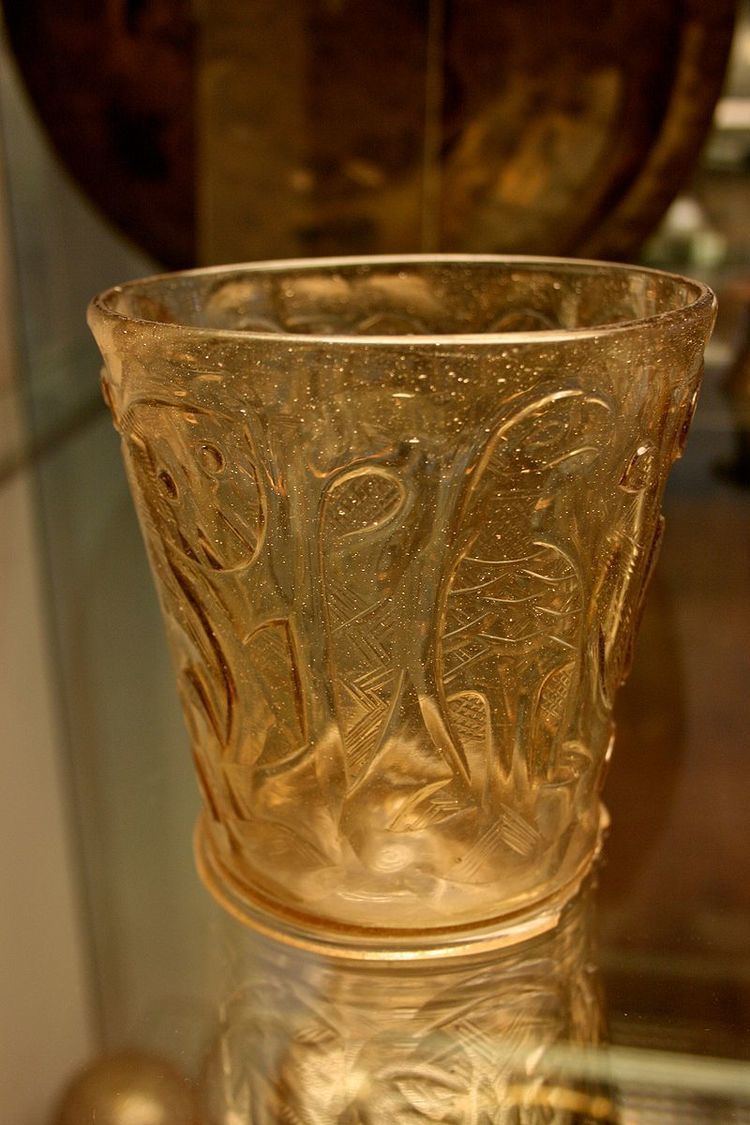 | ||
Hedwig glasses or Hedwig beakers are a type of glass beaker originating in the Middle East or Norman Sicily and dating from the 10th-12th centuries AD. They are named after the Silesian princess Saint Hedwig (1174–1245), to whom three of them are traditionally said to have belonged. So far, a total of 14 complete glasses are known. The exact origin of the glasses is disputed, with Egypt, Iran and Syria all suggested as possible sources; if they are not of Islamic manufacture they are certainly influenced by Islamic glass. Probably made by Muslim craftsmen, some of the iconography is Christian, suggesting they may have been made for export or for Christian clients. The theory that they instead originate from Norman Sicily in the 11th century was first fully set out in a book in 2005 by Rosemarie Lierke, and has attracted some support from specialists.
Contents
Design
All 14 of the complete Hedwig glasses so far known all have roughly the same form: they are squat, thick-walled and straight-sided with a flange around the base. They are around 14 cm high and have a diameter of nearly 14 cm. All but one are richly decorated with wheel-cut relief with hatched details.
The glasses are mostly of a smoky metal colour with a couple of greenish or yellowish glass. The decorations are in two styles: four have abstract decorations derived from Samarra Style C; another eight have zoomorphic decorations of lions, griffins and eagles and palm trees.
They were probably made in emulation of the rock crystal carved vessels made in Fatimid Egypt rather earlier, which were objects of great luxury in the Middle Ages, and have also mostly survived in church treasuries.; an example can be seen in the Treasury of St Mark's Basilica in Venice, which also possesses a rock-crystal ewer in the same style. A number of the glasses were elaborated into reliquaries, or in one case a chalice, during the Middle Ages, with the addition of goldsmith's work, including those at Namur, Krakow and Halberstadt (see below). Lierke suggests that notches in the bases of many indicate that they were originally given other metalwork settings, perhaps as chalices, but none of these have survived. Seven of the known Hedwig glasses have 13th- to 15th-century metal mounts.
Distribution
The Hedwig glasses were clearly high status objects. According to Ettinghausen and Grabar, writing in 1987, so far no examples of this type of glass have been found in the Near East: "all the preserved pieces come from the treasuries of Western churches and noble houses". Small sherds of broken Hedwig glasses have been found in excavations. In common with many Islamic objects imported into medieval Europe, they were credited with more antiquity than was in fact the case. The Amsterdam goblet carries the inscription: "Alsz diesz glas war alt tausent jahr Es Pfalzgraf Ludwig Philipsen verehret war: 1643" ("When this glass was a thousand years old, it was given to Ludwig Philipsen, Count Palatine: 1643")
As of 2009, 14 complete Hedwig glasses and ten additional fragments are known.
Complete
Fragments
The British Museum's example is a "Highlight" object and was selected as the 57th object in the series A History of the World in 100 Objects selected by British Museum director Neil MacGregor and broadcast on BBC Radio 4 in 2010.
